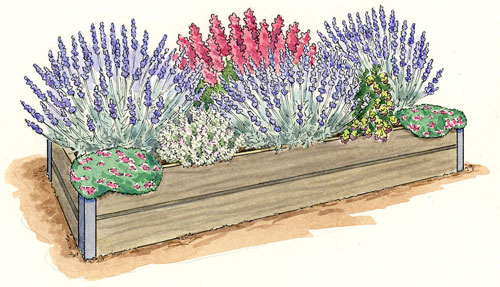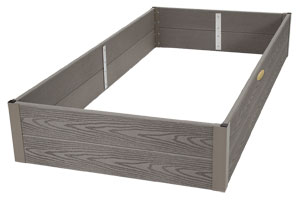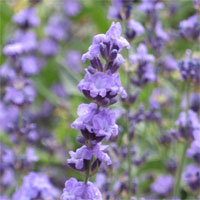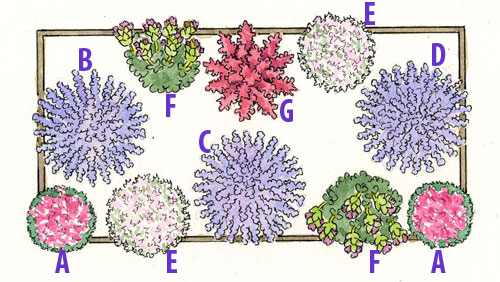






This combination of lavender and Mediterranean plants is designed by David Salman, who gardens in New Mexico. Details of the plan are shown at the end of this article. Illustrations: Carlie Hamilton
By David Salman
Chief horticulturist, High Country Gardens
GROWING lavender can be a challenge for gardeners who live in moist climates (especially those east of the Mississippi) because it requires well-drained soil. The perfect solution is to create a "dry garden" by building a raised bed. Raised beds have become deservedly popular for vegetable gardening, but their versatility makes them useful for a much wider range of gardening uses. The key lies in using a soil mixture that's blended for the plants you're growing — in this case, a freely draining mixture that's suitable for lavender, as well as thyme, oregano and other Mediterranean herbs.

The design is made for a 3' x 6' bed, such as the Forever Raised Bed. A smaller version could be done in a 3' x 3' bed.
The easiest way to build a raised bed is by purchasing a kit, or by using special corner brackets to connect lumber. The most popular sizes for these above ground "containers" are 4' x 4', 3' x 6' and 4' x 8'.
To facilitate drainage, incorporate some of the new soil blend into the top 6" of native soil underneath the raised bed. To calculate the volume of material you will need, use the Soil Calculator.
Lavender is a horticultural treasure that serves us by providing:
English lavender (Lavandula angustifolia) is a small- to medium-sized subshrub with evergreen foliage and woody stems. It has adapted to growing in dry climates with hot summers and mild to cold winters and in lean, well-drained soils.
Regular watering during the first growing season is essential to help your plants get established. Soaker hoses are a convenient and efficient way to water a raised bed. These porous "leaky" hoses drip water directly into the soil, so they moisten roots without wetting the foliage, which helps prevent disease problems. Consider adding a water timer to your system to ensure that plants get the water they need.

Sharon Roberts lavender
I recommend English varieties of lavender (Lavandula angustifolia) because they are the most cold hardy. For best results, be sure to give them plenty of room by spacing them 24" apart.
Recommended lavender varieties:Plant other upright-growing, companion plants to add interest and attract pollinators like hummingbirds. Good choices include agastache (hummingbird hint) and Salvia greggii 'Furman's Red' (bush sage). You can also plant trailing or cascading perennials around the edges of the bed to soften the look. Options include Thymus lanuginosus 'Doone Valley' (woolly thyme), lemon thyme, pink creeping thyme (Thymus praecox ssp. arcticus 'Coccineus'), culinary English thyme (Thymus vulgaris), cascading ornamental oregano (Origanum 'Amethyst Falls') and various annual culinary herbs (basil, marjoram, culinary oregano).

A: Creeping thyme
B: Sharon Roberts lavender
C: Vera lavender
D: Royal Velvet lavender
E: English thyme
F: Amethyst Falls oregano
G: Rosita agastache

David Salman is the founder and chief horticulturist of High Country Gardens and winner of the 2008 American Horticultural Society's Great American Gardener award.
Copyright © www.100flowers.win Botanic Garden All Rights Reserved